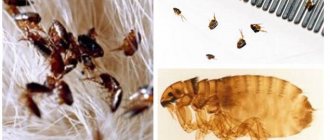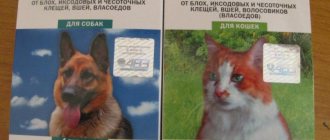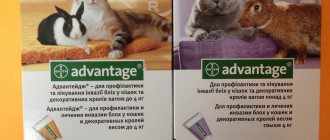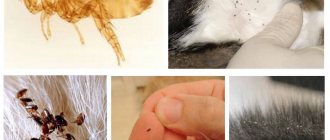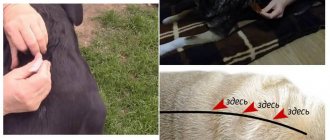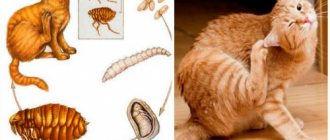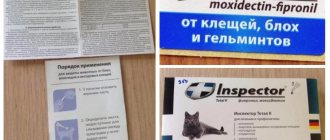What is better for fleas: drops or a collar?
Let’s immediately decide what is better for fleas: drops or a collar. Misconceptions in this matter drive many owners to despair. The fact is that the collar itself is an additional preventive measure. Putting a collar on a flea-infested kitten will not get rid of parasites!
The collar is used as a measure of additional protection, not even against fleas, but against ticks. After treatment with drops, the collar serves as a means of repelling new parasites. In addition, wearing a flea collar before the recommended age can lead to stunted growth and development.
How do flea drops work?
Many owners are interested in how flea drops work. The mechanism of action of the drug depends on the active ingredients. Common flea drops eliminate parasites in several ways:
- Disturbance of nervous activity - the flea drinks blood, after which paralysis and death occurs.
- Contact action - the poison penetrates the body of the parasite through direct contact.
- Repellent effect - some flea drops do not kill, but only repel parasites with their smell.
Important! The duration of action depends on the type of active ingredients and their dosage. Most often, drops protect a cat from fleas for 8 weeks, and from ticks for 4 weeks.
How often should I treat my kitten for fleas?
How often do you treat a kitten for fleas as a preventive measure? According to generally accepted rules, preventive treatment against parasites is carried out quarterly. The period is considered optimal to interrupt the reproduction cycle of most parasites.
If a cat is infested with fleas, treatment is carried out outside the schedule. If infection is repeated, it is recommended to change the drops, since their protective effect should protect the kitten from 4 to 8 weeks (depending on the drug). Shampoos and some flea sprays do not have a prolonged action, that is, they kill fleas “here and now,” but the very next day the kitten can “pick up” fleas again.
Pay attention! If infected with subcutaneous mites, as prescribed by a veterinarian, treatment may be carried out more often.
When can you wash your kitten after applying the drops?
When can I wash my kitten after flea treatment? Typically, this information is indicated in the instructions for the drops. The absorption time of the drops depends on the base of the drug. oil drops cannot be washed off for 4–5 days; water-based preparations are absorbed faster, in 1–2 days.
The kitten should be bathed immediately if it has a local reaction to the use of drops. Symptoms of an allergic reaction include: redness, itching, swelling, and the appearance of fresh scratches. In rare cases and in case of overdose, the kitten may experience a reaction from the nervous system: drooling, convulsions, apathy.
Pros and cons of drops
Before making any choice, you need to study all the pros and cons, find out how flea drops for cats work and how harmless they are. All such substances are produced in the form of concentrated solutions based on insecticides, which are essentially poisons.
They penetrate the dermis (the top layer of skin), saturate the hairs, starting with the hair follicles, and fill the sebaceous glands under the skin. Their function is a neuroparalytic effect; the parasites lose the ability to move and die as a result.
Spreading over the upper integument, they do not reach the circulatory system or the stomach, so there is no serious harm to the cat’s health. Moreover, the doses required for treatment are very small. Usually a small drop is enough to neutralize pests for a long time.
The main advantages of these concentrates should be considered:
- minimal danger due to the specific method of application. It is difficult for a cat to reach the withers to lick the application site;
- low level of toxicity. A minimal area treated superficially does not affect other organs;
- simplicity, convenience and long-term effect. The applied drop provides a lasting result and at the same time provides prevention;
- fast reaction. Some products provide the desired effect within 15 minutes.
- reasonable price for most of the drops offered;
- great functionality. Almost all drugs have an extended spectrum; they act on most parasites;
- versatility. They are suitable for various cat breeds, regardless of the structure and length of the coat.
Negative points usually include:
- relatively high payment for the purchase of imported drops,
- some isolation of the treated animal, when the medicine must be absorbed, although not for long;
- short-term wool contamination,
- Some drops have quite a strong aroma.
How to use such medications? First, carefully spread the hairs on the withers, then apply the required amount, and then thoroughly rub it into the skin. After these manipulations, the cat should not be combed or bathed for approximately 62 hours. After the period indicated in the instructions, wash your pussy with shampoo.
Usually one treatment per month is sufficient. Buy only those drops that are designed specifically for cats. There is no need for replacements, this is fraught with side situations. And special attention must be paid when processing kittens. Curious little ones begin to lick each other's drops, and the mother cat immediately joins them.
Therefore, when buying medication, be sure to take into account when you have a pregnant or lactating cat with kittens. In this case, the right thing to do would be to contact a veterinarian. He will help you calculate the correct dose and advise you to choose the drug.
By the way, there are often cases when pets are frightened by the owner’s manipulations with pipettes and tubes near their neck, but you should not force him to do the procedure. Be patient, wait for him to calm down, and then complete the process.
Instructions: how to apply flea drops
Each package of drops contains instructions on how to give the kitten the drops. The instructions indicate indications and contraindications that must be studied first. Typically, the contraindications section indicates the minimum permissible age for processing.
The generally accepted rules for treating animals against fleas using drops include:
- The product is applied to intact, dry skin.
- Drops are applied to the back of the head or shoulder blades, so that the kitten does not reach the treated areas while washing.
- During the first hours after treatment, the kitten must be closely monitored as side effects may occur.
- If you are unable to ensure that the kitten does not lick the drops, you need to put an Elizabethan collar on it.
When treating kittens, it is not recommended to use products whose dosage is designed for large weights, for example 1 ml per 10 kg of body weight.
In addition, it is strictly not recommended to use drugs intended for dogs when treating cats.
How do these drugs work?
Even cats that do not leave the house are likely to become infected with blood-sucking parasites and worms. According to the recommendations of veterinarians, drops against fleas and worms for cats with access to the street are carried out once a month for preventive purposes, for pets with limited access from home - at least once every 3 months. For cats that do not like the use of oral medications and frequent bathing, manufacturers of animal medicines have developed drops on the withers that can destroy external and internal parasites with a single application.
Anthelmintic drops for cats
The natural desire of many cat owners is to find out the answer to the question: how does a drug applied to the pet’s withers work against parasites inside the intestines? Such drops contain substances that cause paralysis of the nerve and muscle endings of helminths. Once on the skin of the cat’s withers, the drug is absorbed through the epidermis, spreads throughout the body and is absorbed into the tissues.
Within 24 hours, the drug destroys fleas, ticks and worms that feed on blood and tissues saturated with a substance that is toxic to them. The concentration of the active substance is small and safe for cats, but it is destructive for smaller internal and external parasites.
For your information! Features of the drops of complex effects are the long period of elimination of the active substance and its ability to accumulate in the sebaceous glands of the cat, which creates a protective barrier against parasites.
Basic rules for using drops against fleas and worms for cats:
- the cat's skin must be dry, without any damage (scratches, abrasions, wounds);
- before treating a pet, the owner must wear rubber gloves;
- the pipette on the bottle is opened immediately before starting to treat the cat and is disposed of immediately after use;
- the drug is intended for external use only, therefore it is applied to inaccessible places from which the cat cannot lick drops, for example, on the skin of the withers. After application, the drops do not rub in;
- the dosage of the drug is strictly calculated according to the instructions, taking into account the weight, age and health of the cat;
- after treatment, it is recommended to limit the pet’s access to the street and not bathe for 2-3 days;
- it is important to ensure that treated pets do not lick each other (for example, a mother cat and kittens) and do not become poisoned;
- The purchased drug is stored out of the reach of children and pets.
A repeated procedure for treating a pet with complex action drops is carried out 10 days after the first.
How to rid a kitten of fleas without using medications
If the kitten cannot be treated with traditional flea drops, parasites can be removed using folk remedies. Using safe methods takes time and diligence. Ultimately, the parasites are removed manually by combing out.
Important! If a kitten has a severe flea infestation, it is better to consult a veterinarian who will assess the risks and potential medicinal effect of certain medications.
Common folk remedies for removing fleas are:
- A decoction of wormwood, tansy and eucalyptus.
- Natural apple cider vinegar.
- Infusion or decoction of fresh pine needles.
- Citrus infusion.
All of the above products have an unpleasant odor, which irritates and repels parasites. It is important to understand that the smell of apple cider vinegar and citrus fruits will be extremely unpleasant to the kitten. An animal may have an allergic reaction to a decoction of herbs.
At 1 month
At 1 month of age, kittens cannot be treated for fleas with traditional products. Absolutely all drops are toxic and can adversely affect the baby’s nervous system. At such a young age, a kitten can only be rid of fleas by hand.
To comb out parasites, you need a fine-tooth comb and your patience. To prevent fleas from biting and jumping off the kitten onto the floor, it is better to comb the fur with water and lemon juice. After the procedures, it is not recommended to bathe the kitten!
At 2 months
At 2 months (8 weeks), a kitten can be rid of fleas using drops. Almost all products can be used from 8 weeks. However, some drops are strongly recommended to be used only under medical supervision.
At the age of two months, the kitten can be bathed using anti-flea shampoos. Naturally, when using shampoos, you must follow safety precautions and thoroughly rinse the product from your pet’s fur. Until the kitten is dry after bathing, it must be protected from drafts and ensure that it does not lick itself.
Side effects
All prophylactic drugs intended to combat parasites are toxic. Drops released for treating kittens are usually classified as moderately toxic substances. It is important to understand that the conditional safety of the drops implies exclusively external use and the absence of an individual allergic reaction.
If you are treating a kitten with an unknown medical history, you should use the safest possible drops and consult your veterinarian first. In most cases, kittens picked up on the street or bought at a poultry market are infected not only with fleas, but also with worms. In case of mixed invasion, it is much more reasonable to use complex drugs (for external and internal parasites) in the form of drops.
Kitten itches after flea drops
In rare cases, if there is an individual intolerance to the active ingredients of the drops, the animal may experience an allergic reaction. If the kitten itches after flea drops, it is necessary to inspect the treatment area. Alarming symptoms are: redness, swelling and local fever. If you notice symptoms of an allergic reaction, the remaining droplets must be washed off from the kitten’s fur and skin.
In the absence of an allergic reaction, after treatment with drops, the kitten may itch during the day. The fact is that most drops quickly paralyze fleas, but the death of parasites can occur within several hours. An allergic reaction to already inflicted flea bites can last up to 12–20 hours. In addition, gentle drugs can only affect adults. In this case, the treatment is repeated after 4–10 days (according to the instructions or prescription of the veterinarian).
Drops for cats BAYER ADVOCATE against scabies mites, fleas and helminths (4-8 kg weight) 0.8 ml, 1 pipette
Drops on the withers Advocate is a complex drug from the German manufacturer Bayer that helps you protect your dog from a wide range of external and internal parasites. Properties of the drug: • a complex drug that acts on external (scabies mites, fleas) and internal (worms) parasites; • acts on subcutaneous mites, which can cause itching in a dog and lead to diseases such as otodectosis, sarcoptic mange, demodicosis; • acts on fleas on the dog and in the environment, which allows you to get rid of already deposited flea larvae, which can be found everywhere where the dog likes to be (bed, carpet, sofa, etc.); • acts on intestinal worms, as well as especially dangerous worms, the adults of which live in the dog’s heart, as well as heartworms under the skin. These parasites have been recorded throughout Russia, and are especially common in the south of Russia; drops on the withers for dogs weighing more than 25 kg, suitable for monthly use. It is convenient to dose according to the dog’s weight and apply to the withers. COMPOSITION AND RELEASE FORM Advocate contains imidacloprid (10%) and moxidectin (1%) as active ingredients, as well as auxiliary components. It is a transparent solution from yellow to brown color for external use. Packaged in 0.4 ml and 0.8 ml in propylene pipettes of appropriate capacity. Pack 3 pipettes in blisters made of aluminum foil, which are placed in cardboard boxes.
PHARMACOLOGICAL PROPERTIES Advocate has a wide spectrum of antiparasitic effects. Treatment and prevention of flea infestation (Ctenocephalidesfelis), treatment of allergic flea dermatitis, treatment of otodectosis caused by Otodectescynotis, prevention of dirofilariasis (destroys microfilariae L3 and L4 Dirofilariaimmitis), treatment of gastrointestinal nematodes (L4 larvae, immature and adults of Toxocaracati, Ancylostomacati, Ancylosto matubaeforme).
INDICATIONS Prescribed to cats weighing 4-8 kg for the treatment and prevention of nematodes, entomosis, sarcoptic mange (including sarcoptic mange and otodectosis) and demodicosis.
DOSES AND METHOD OF ADMINISTRATION Advocate is used by animals by drip (“spot-on”) application to dry, intact skin. Before use, remove the protective cap from the pipette and, positioning it vertically, pierce the protective membrane of the pipette nose (putting the cap on the back side), then remove the cap again. The drug, by spreading the fur, is applied to the animal in places inaccessible for licking, directly on the skin between the shoulder blades at the base of the neck. The minimum therapeutic dose is 10 mg/kg live weight of imidacloprid and 1.0 mg/kg body weight of moxidectin, which is equivalent to 0.1 ml/kg weight of the drug Advocate for cats To kill fleas and lice, animals are treated once, to prevent re-infestation - once at four to six weeks throughout the insect season. In a comprehensive program for the prevention and treatment of allergic dermatitis caused by fleas, Advocate is used once a month.
To treat otodectosis (ear scabies), the drug is applied to the skin once. During the treatment process, it is recommended to clean the ear canal of exudate and scabs, and in case of complications with otitis media, prescribe antimicrobial and anti-inflammatory drugs. If necessary, the course of treatment is repeated after a month.
For therapeutic purposes, the drug is prescribed 2 times for sarcoptic mange, and 2-4 times for demodicosis with an interval of 28 days; in order to prevent possible invasion - once a month. Treatment of demodicosis is recommended to be carried out comprehensively using etiotropic, pathogenetic and symptomatic drugs.
To deworm animals with nematodes of the gastrointestinal tract, the drug is used for therapeutic purposes once, and for prophylactic purposes - once a month.
In order to prevent dirofilariasis in regions unfavorable for the disease, the drug is used in the spring-summer-autumn period before the start of the flight of mosquitoes and mosquitoes (carriers of the pathogen D. immitis) once, then once a month and the last time in the season no earlier than 1 month after completion of insect flight. Advocate does not destroy sexually mature dirofilariae, but reduces the number of microfilariae circulating in the blood and can also be safely used by infested animals.
SIDE EFFECTS There are, as a rule, no side effects or complications when using the drug Advocate in accordance with these instructions. In rare cases, the animal may experience individual reactions (redness of the skin, itching), which resolve spontaneously and do not require the use of medications. The drug is bitter, therefore, if an animal licks the application site after treatment, in rare cases drooling is possible, which is not a sign of intoxication and goes away after a few minutes; sometimes, when licking, nervous phenomena may occur that quickly pass. Correct application of the drug minimizes the possibility of animals licking the application.
CONTRAINDICATIONS Advocate should not be used by sick, weakened animals, as well as cats weighing less than 1 kg and kittens under 9 weeks of age. Do not use simultaneously with other drugs containing macrocyclic lactones.
SPECIAL INSTRUCTIONS Pregnant and lactating cats should be treated with caution under the supervision of a veterinarian.
STORAGE CONDITIONS: In sealed manufacturer's packaging, in a dry place, protected from light, inaccessible to children and animals, separately from food and feed, at a temperature of 0 to 30ºС. Shelf life: 36 months from the date of manufacture, subject to storage conditions.
Read more
Review of popular flea drops - application, indications and contraindications
Never believe what it says on the label! That’s right, if the drops say “for kittens,” most likely we are talking about animals older than 2–3 months. For reference, animals under 9–12 months of age are also considered kittens, so manufacturers do not lie when they place colorful labels on packages.
Important! There are no absolutely safe flea drops. Always read the instructions before use! If you have any doubts about the safety of the drug, it is better to consult a veterinarian.
Leopard
The drug differs from most drops in the number of components. The main active ingredients of Bars drops are:
- Fipronil.
- Diflubenzuron.
- Dicarboximide.
Interacting, the active substances give a relatively good result, against the background of low toxicity. Once in the body of parasites, the active substances disrupt the functioning of their nervous system, which quickly leads to paralysis, and within 2-4 hours to death. In addition, Bars drops have a detrimental effect not only on adult parasites, but also on their eggs. Simply put, drop treatment interrupts the flea reproduction cycle, and this is very important at any stage of the infestation.
Indications for use: elimination of skin parasites, including fleas, lice, lice, subcutaneous and pasture ticks in animals older than 2 months.
Contraindications to the use of Bars drops:
- Individual intolerance.
- Acute allergic reactions.
- Immunocompromised animals: dehydrated, malnourished, sick or recovering from illness.
- Carriers of a viral infection.
- Kittens under 8 weeks and cats over 12 years old.
- When treating ear mites, the use of drops in case of perforation of the eardrum is not recommended.
According to the manufacturer, the active ingredients are distributed throughout the deep layers of the skin without penetrating into the systemic bloodstream. When used externally, the drug is considered moderately toxic, but drops must be used observing all safety precautions. Upon contact with mucous membranes, the active ingredients of Bars drops cause irritation; if swallowed, the toxicity of the drug increases sharply.
The recommended dosage is as follows:
- Cats weighing up to 1 kg – 0.3 ml.
- Cats weighing 1–3 kg – 0.6 ml.
- Cats weighing more than 3 kg – 1 ml.
Important! Drops are applied only to dry, intact skin.
Celandine
According to the manufacturer, Celandine drops can be used to prevent and treat infestations of skin parasites in kittens and adult cats. The residual effect of the drug lasts up to 2 months against fleas and up to 1 month against pasture ticks.
The active ingredients of Celandine drops are:
- Fipronil.
- Permethrin.
The range of the drug is aimed at combating external parasites: fleas, lice, lice and ticks. In addition, Celandine is prescribed for the treatment of subcutaneous mites. According to the manufacturer, the composition of the drops helps to effectively fight parasites at different stages of growth (from egg to mature individual). The active ingredients of the drops disrupt nerve conduction in parasites, which leads to their paralysis and death.
Contraindications to the use of Celandine drops:
- Kittens under 8 weeks old.
- Cats over 12 years old.
- Animals suffering from liver and kidney pathologies.
- Virus carriers.
- Weakened, emaciated, dehydrated animals.
- Animals that are sick or recovering from illness.
Note! When used externally in recommended doses, the drug is classified as moderately dangerous. Upon contact with mucous membranes, the active substances cause severe irritation. When licked and swallowed, drops can lead to both local reactions (salivation, allergies) and poisoning.
The dosage of Celandine drops is calculated by the weight of the animal:
- For cats weighing up to 2 kg – 0.5 ml.
- For cats weighing over 2 kg – 1 ml.
Imported means of production
Advocate
Veterinary drug used for the treatment and prevention of nematodosis, demodicosis, entomosis and sarcoptoidosis, intended for external use. The product is characterized by a very wide range of effects against parasites - it allows you to effectively fight fleas, ticks, lice, lice, and even helps cope with worms and intestinal nematodes living inside the animal. The drug belongs to the group of moderately hazardous substances. If the dosage is observed, dogs and cats tolerate its effects well. These are products of the German company Bayer, which has been producing medicines for people and animals for many years. The solution is packaged in pipettes, the volume of which can vary from 0.4 to 4 ml. The main active ingredients here are moxidexin and imidacloprid; additional components are also present - propylene carbonate, benzyl alcohol and butylated hydroxytoluene. After application to the skin, the drug actively spreads throughout the animal’s body within a couple of hours without being absorbed.
The product is securely attached to the wool, which ensures a long exposure time. Moxidectin is absorbed into the skin, penetrating into tissues and the circulatory system. Its highest concentration in the animal’s body is reached on days 5-6 and is completely eliminated within a month. If you need to rid your pet of parasites living in the fur, then a single treatment will be enough; when you have to fight internal parasites, you will have to re-apply the drug - this is done after about 3-4 weeks. If the product is used for preventive purposes, the animal must be treated after bathing without shampoo.
More: How to properly add treats to your domestic cat's diet?
Advantages:
- Very effective;
- Has water-resistant characteristics;
- Extended spectrum of action.
Flaws:
- Not all animals tolerate it well;
- High price.
Advocate
Frontline Combo
Very effective drops, which are easy to use, can quickly get rid of blood-sucking insects. This product is produced by the French company Merial, which is known throughout the world for its discoveries in the field of veterinary medicine. The drug has unique properties; it penetrates under the chitinous cover of insects, acts at the cellular level, which initially leads to paralysis of the nervous system of fleas, and subsequently causes their death. In some cases, the larvae and eggs of bloodsuckers remain intact, which is why the animal's fur will need to be re-treated, which is carried out after eight weeks. It is not recommended to apply to the skin of a pet if its age does not exceed 2 months. The drops penetrate deep into the epidermis, making it possible to provide complete protection. The dosage is calculated based on the weight of the animal. After the treatment has been carried out, you should limit the pet’s contact with children, minimize exposure to the open air, and you should also not bathe it.
The drug also has a calming effect - it helps get rid of itching after bites, prevents flea dermatitis, and prevents infection of the apartment. The product copes with all types of ticks. It must be kept on the animal’s skin for about two days, after which the dog or cat is allowed to be bathed. Fipronil is used as the main active agent. The animal will be completely protected from fleas for the next three months.
Advantages:
- Widely used drug;
- Actively fights fleas and ticks, as well as the consequences of their bites;
- Long lasting.
Flaws:
- Cannot be used if the animal is under at least two months old.
Frontline Combo
Stronghold Pfizer
American-made products are based on selamectin, a chemical compound that not only kills adult fleas and ticks, but also blocks the incubation of their eggs. It is also suitable for combating ear and scabies mites, helps cope with heartworm, which can affect a pet’s heart, and can be used when treating an animal for roundworms and hookworms. The product dries very quickly, has no foreign odor, and is highly moisture resistant. Safe for pets if they are over 6 weeks old. Tests of its action were carried out even on the most sensitive breeds of dogs and cats - no allergic reaction was detected, although cases of individual intolerance to the drug were encountered.
The drug has an inhibitory effect on chlorine channel receptors. As a result, the normal transmission of nerve impulses in the synapses of the muscle tissue of the parasites is disrupted. Selamectin is absolutely safe for animals - after application, it is almost instantly absorbed into the skin and enters the circulatory system, without causing any harmful effects on the pet’s body. The maximum concentration is achieved one day after treating the cat and three days if the drug was applied to the dog's fur. The therapeutic concentration of the substance is maintained for a whole month. This product is also absolutely safe for people, so immediately after the drug is absorbed, the animal can be petted, picked up, bathed and played with.
Advantages:
- Absorbed into the blood very quickly;
- An expanded list of parasites that this drug can fight;
- The required concentration is quickly achieved.
Flaws:
- Not a very convenient form of release.
Stronghold Pfizer
Bravecto Spot On
It begins to act very quickly - after treating the skin, the product begins to rid the animal of fleas in just 4 hours, and after another 4 hours, about 98% of the insects living in the pet’s fur die. After about a day, the pet has a death rate of fleas and ticks that is close to 100%. This drug is a fairly effective solution in the fight against flea dermatitis. During the development of the drug, studies were carried out on all varieties of ixodid ticks, both on adults and on eggs and larvae. Ticks will die regardless of which part of the animal’s body they are attached to. This drug was developed specifically for cats and dogs, and its degree of toxicity is so low that it is allowed to be used if the animal is pregnant or nursing offspring. Adaptability in fleas to this drug is not observed.
The principle of action is as follows: the active substance penetrates under the chitinous cover of the animal, blocks the work of nerve impulses and the digestive system. The insects stop feeding, so literally immediately after application the animal’s level of discomfort decreases - it begins to itch less and hardly licks itself. The key ingredient here is fluralaner, which is a mammal-safe insecticide. It penetrates into the circulatory system, maximum concentration is achieved just a day after use.
Advantages:
- Easy to use;
- Begins to act almost immediately after application;
- Suitable for lactating and pregnant individuals;
- Actively fights fleas and ticks;
- Safe for animals and people.
Flaws:
- It's very expensive.
Bravecto Spot On
UltraGuard Plus Drops
The leader in this section of our review of the best drops for fleas and ticks is the product developed by a well-known American company that specializes in the production of various veterinary drugs. The composition can be used if the animal is at least 12 weeks old. It will have to be applied to dry and intact skin; it is advisable to cover the area from the withers to the root of the tail. Due to the fact that the animal can reach out and lick the product off, it is advisable to put a muzzle or a special collar on it. The composition should not be applied to the skin of sick or convalescent animals. If your pet is bearing or feeding offspring, you should definitely consult a veterinarian before use. If all these points are observed, there are no contraindications or side effects, however, there are cases of individual intolerance.
More: Top 10 plastic boats for fishing, how to choose a plastic boat
The drops are absorbed quite quickly - it takes about two hours, after which the body of the dog or cat becomes completely invulnerable to parasites. As soon as a tick or flea tries to bite a pet, the insect immediately dies. In addition, the drug has a preventive effect, preventing pests from re-entering the wool over the next 30 days, after which the skin will need to be re-treated.
Advantages:
- One package is enough for three treatments, that is, for most of the summer season;
- Protects against ticks, mosquitoes and fleas;
- Penetrates deep into the skin and begins to act almost immediately after application to the animal.
Flaws:
- The need to use a muzzle or collar to prevent the pet from licking it off.
UltraGuard Plus Drops
